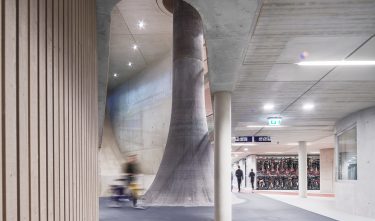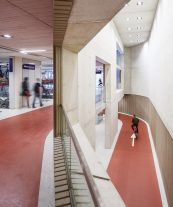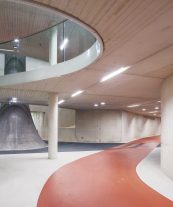During the recent presentation of Dutch Design Awards, someone asked me about the meaning of ‘Habitat’. Both the questioner and I found my answer as brief as it was unsatisfactory: ‘Actually everything’.
 1
1
The biggest shortcoming of this description is, of course, that everything does not exclude anything. This can be a good characteristic in another context, but when defining and qualifying the framework of a certain category of designs, stretching the boundaries does not really help. Nevertheless, my somewhat impulsive qualification on the evening in question was not entirely based on laziness or carelessness because ‘Habitat’, as seen from several different perspectives, is truly comprehensive; it has to be.
Whether it is the interior design of a modest classroom for toddlers or a large high-tech bridge that supports thousands of cars every day, these are always designs that define our lives. It is design that gives meaning, value and colour to our living environment. ‘Habitat’ is design that, in the broadest sense of the word, guides our lives in all possible variations and degrees. It is design that is almost always visible all around us. We sometimes have to look for it, sometimes it is unavoidable and intrusive. ‘Habitat’ is, almost without exception, design that defines and confirms our way of life.
The definition formulated by Dutch Design Awards for this category also emphasises this: ‘The design and layout of private and public spaces that benefits the quality of life.’ Put it to the test and undertake a random world tour that takes you through different countries, with just as many different views and interpretations of the (qualitative) design of the private and public spaces. You will suddenly realise how much we benefit from and present ourselves through good design.
— If we want to prevent our future ‘Habitat’ being primarily defined by unilateral technological or political reactions to various crises, design must explicitly continue to play a role.
 2
2
 3
3
And yet concepts such as living environment, quality of life and ‘identity-confirming’ designs probably generate just as many questions as the term ‘Habitat’ does. In order to be and to remain unambiguous, it is therefore useful and necessary to continually identify and constantly interpret the condition of our ‘Habitat’ and living environment. Design can then continue to make a contribution in a correct and constructive way.
Gauging our ‘Habitat’ is extremely urgent in this. While we have been working steadily for decades and relying and building on the (modernist) blessings of the spatial planning of our artificial land and landscape, various recent developments, often on a global scale, have significantly changed the playing field in our country. The government has started to decentralise, we have to react to and anticipate the consequences of climate change, an energy transition has been reluctantly initiated, mobility is undergoing a transition and our current use of scarce raw materials is increasing the demand for circular processes.
These are all challenges and developments that lead to innovative, technical or technological solutions. But from the perspective that these new developments will also define our ‘Habitat’ (and broaden it further), the connection with design is a logical and critical condition. If we want to prevent our future ‘Habitat’ being primarily defined by unilateral technological or political reactions to various crises, design must explicitly continue to play a role. Various nominations in the ‘Habitat’ category in recent years have luckily proven beyond doubt that design flourishes particularly well in this new ‘Habitat’. I refer specifically to the People’s Pavilion by Overtreders W and bureau SLA (assignment: circular construction), the Zaligebrug by NEXT architects (assignment: climate change) and the world’s largest bicycle parking facility by Ector Hoogstad (assignment: new mobility landscapes).
I am curious who, what and how much will follow…
JaapJan Berg, DDA jury member and committee chair in the category ‘Habitat’